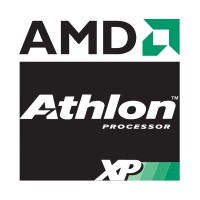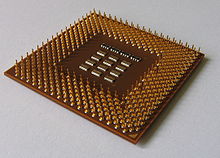AMD Athlon XP
| << AMD Athlon XP >> | |
|---|---|
 |
|
| Production: | 2001 to 2004 |
| Producer: | AMD |
| Processor clock: | 1333 MHz to 2333 MHz |
| FSB cycle: | 133 MHz to 200 MHz |
| L2 cache size: | 256 KiB to 512 KiB |
| Instruction set : | x86 |
| Microarchitecture : | AMD K7 |
| Base: | Socket A (462) |
Names of the processor cores:
|
|
Athlon XP is the name for a series of x86 -compatible processors from AMD . The identical multi-processor variant is called the Athlon MP .
development
The Athlon XP is the successor to the original Athlon . While the first model series called Palomino and Thoroughbred (T-Bred) still had to get by with an L2 cache of 256 KiB, the newer models in the Barton series bring it to 512 KiB L2- Cache. In the small processors for 133 MHz FSB (2000+ to 2600+) the Thouroughbred core was replaced by the Thorton (Barton core with halved L2 cache) at the end of 2003 .
With the Athlon XP, AMD introduced various innovations, e.g. B. the QuantiSpeed rating system or the SSE commands of the Pentium III . This QuantiSpeed rating did not indicate the actual clock frequency in the product name, but initially a QuantiSpeed rating, which was based on an Athlon Thunderbird with the corresponding clock frequency. In reality, the rating was based on Intel's Pentium 4, but this comparison had some pitfalls. For example, the Athlon XP often performs better in games, while the Pentium 4 is ahead in video compression. In these comparative tests ( benchmarks ) there is the fundamental problem that different models are defined by their manufacturers using the performance ranges in which they perform best. Complete comparability can hardly be achieved in this way. Apart from the name of the processor and the clock rates, the application-relatedness and the price-performance ratio should always be taken into account when making a comparison. In the latter area, AMD usually offered the customer significant advantages.
The Thoroughbred B has additional copper connectors to reduce interference.
Another modification aimed at the entry-level / office market is the Sempron , which is based on the T-Bred / Thorton.
The successor to the Athlon XP was the Athlon 64 .
QuantiSpeed rating
With regard to the rating system, it is noteworthy that the rating overlaps between the model series in individual cases : For example, the models with 133 MHz FSB have the Palomino with ratings from 1500+ to 2100+ and two variants (A and B) Thoroughbred (T-Bred) with ratings from 1600+ to 2200+ (A) or 1600+ to 2600+ (B), some of which are operated with different voltages. Models with 166 MHz FSB are available as Thoroughbred-B with ratings from 2600+ to 2800+ and as Barton with ratings from 2500+ to 3000+. Models with 200 MHz FSB are available as Barton and Thorton with ratings of 3000+ and 3200+ (Barton) and 3100+ (Thorton). With the Barton , the L2 cache was increased to 512 KiB again, which enabled a higher rating at a lower clock rate. The Thorton is a Barton with a halved (partially deactivated) L2 cache and intended as a replacement for some T-Bred models (see listing).
In short: The models XP 1600+ to XP 2200+ and XP 2600+ to XP 3000+ can be confused or misled. When purchasing such a processor, you should therefore find out exactly which of the variants you are getting so that there are no unpleasant incompatibilities.
Model data
Palomino
- L1 cache: 64 + 64 KiB (data + instructions)
- L2 cache: 256 KiB with processor clock
- MMX , Extended 3DNow! , SSE
- Socket A (462) , EV6 with 133 MHz Front Side Bus (FSB 266)
- Operating voltage (VCore): 1.75 V.
- Release DATE: October 9, 2001
- Manufacturing technology: 0.18 µm
- The size: 129.26 mm² with 37.5 million transistors
- Clock rates: 1.333-1.733 GHz
- 1500+: 1.333 GHz [9. October 2001]
- 1600+: 1.400 GHz [9. October 2001]
- 1700+: 1.466 GHz [9th October 2001]
- 1800+: 1.533 GHz [9. October 2001]
- 1900+: 1.600 GHz [5. November 2001]
- 2000+: 1.667 GHz [7. January 2002]
- 2100+: 1.733 GHz [13. March 2002]
Thoroughbred A
- L1 cache: 64 + 64 KiB (data + instructions)
- L2 cache: 256 KiB with processor clock
- MMX , Extended 3DNow! , SSE
- Socket A (462) , EV6 with 133 MHz Front Side Bus (FSB 266)
- Operating voltage (VCore): 1.50-1.65V
- Release DATE: June 2002
- Manufacturing technology: 0.13 µm
- The size: 80.89 mm², 84.66 mm² or 86.97 mm² with 37.2 million transistors
- Clock rates: 1.4–1.8 GHz
- 1600+: 1.4 GHz
- 1700+: 1.466 GHz
- 1800+: 1.533 GHz
- 1900+: 1.6 GHz
- 2000+: 1.667 GHz
- 2100+: 1.733 GHz
- 2200+: 1.8 GHz
Thoroughbred B
- L1 cache: 64 + 64 KiB (data + instructions)
- L2 cache: 256 KiB with processor clock
- MMX , Extended 3DNow! , SSE
- Socket A (462) , EV6 with 133 and 166 MHz Front Side Bus (FSB 266 and FSB 333)
- Operating voltage (VCore): 1.50-1.65V
- Release DATE: August 2002
- Manufacturing technology: 0.13 µm
- The size: 80.89 mm², 84.66 mm² or 86.97 mm² with 37.2 million transistors
- Clock rates: 1.4–2.25 GHz
- FSB 266:
- 1600+: 1.4 GHz [March 2003]
- 1700+: 1.466 GHz [December 2002]
- 1800+: 1.533 GHz [December 2002]
- 1900+: 1.6 GHz [December 2002]
- 2000+: 1.667 GHz [December 2002]
- 2100+: 1.733 GHz [December 2002]
- 2200+: 1.8 GHz [August 2002]
- 2400+: 2.0 GHz [August 2002]
- 2600+: 2.133 GHz [August 2002]
- FSB 333:
- 2600+: 2.083 GHz [November 2002]
- 2700+: 2.167 GHz [October 2002]
- 2800+: 2.25 GHz [October 2002]
- FSB 266:
Thorton
Barton with halfway disabled L2 cache
- L1 cache: 64 + 64 KiB (data + instructions)
- L2 cache: 256 KiB with processor clock
- MMX , Extended 3DNow! , SSE
- Socket A (462) , EV6 with 133, 166 and 200 MHz Front Side Bus (FSB 266, 333 and 400)
- Operating voltage (VCore): 1.50-1.65V
- Release DATE: May 2003
- Manufacturing technology: 0.13 µm
- The size: 100.99 mm² with 54.3 million transistors
- Clock rates: 1.667–2.2 GHz
- FSB 266:
- 2000+: 1.667 GHz [May 2003]
- 2200+: 1.8 GHz [May 2003]
- 2400+: 2.0 GHz [May 2003]
- FSB 333:
- 2600+: 2.083 GHz [May 2003]
- FSB 400:
- 3100+: 2.2 GHz [October 2004]
- FSB 266:
Barton
- L1 cache: 64 + 64 KiB (data + instructions)
- L2 cache: 512 KiB with processor clock
- MMX , Extended 3DNow! , SSE
- Socket A (462) , EV6 with 133, 166 and 200 MHz Front Side Bus (FSB 266, 333 and 400)
- Operating voltage (VCore): 1.65 V.
- Power consumption ( TDP ): 68.3 W, 74.3 W (at 2,167 MHz), 76.8 W (at 2,200 MHz)
- Release DATE: February 10, 2003
- Manufacturing technology: 0.13 µm
- The size: 100.99 mm² with 54.3 million transistors
- Clock rates: 1.833-2.333 GHz
- FSB 266:
- 2800+: 2.133 GHz [only for OEMs , release unknown]
- FSB 333:
- 2500+: 1.833 GHz [February 2003]
- 2600+: 1.917 GHz [June 2003]
- 2800+: 2.083 GHz [February 2003]
- 3000+: 2.167 GHz [February 2003]
- 3200+: 2.333 GHz [November 2003] (only for OEMs)
- FSB 400:
- 3000+: 2.1 GHz [April 2003]
- 3200+: 2.2 GHz [May 2003]
- FSB 266:
Web links
- AMD Athlon processors ( Memento October 1, 2007 in the Internet Archive ) AMD product information
- AMD's technical specifications ( Memento from February 6, 2007 in the Internet Archive ) for the K7 generation (PDF; 184 kB; English)







